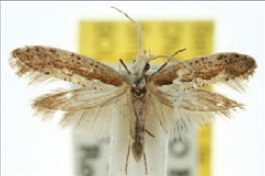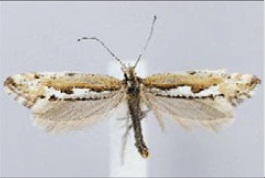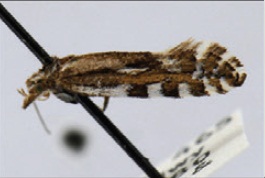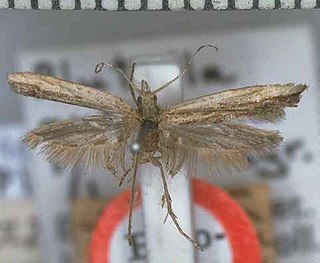The term cabbage worm is primarily used for any of four kinds of lepidopteran whose larvae feed on cabbages and other cole crops. Favorite foods include broccoli, cauliflower, Brussels sprouts, collards, kale, mustard greens, turnip greens, radishes, turnips, rutabagas and kohlrabi. This small group of similar pest species is known to agriculturists as the cabbage worm compte butterflies.

The diamondback moth, sometimes called the cabbage moth, is a moth species of the family Plutellidae and genus Plutella. The small, grayish-brown moth sometimes has a cream-colored band that forms a diamond along its back. The species may have originated in Europe, South Africa, or the Mediterranean region, but it has now spread worldwide.

The Plutellidae are a family of moths commonly known as the diamondback moths, named after the diamondback moth of European origin. It was once considered to have three subfamilies: Plutellinae, Praydinae, and Scythropiinae. Praydinae was later elevated to its own family, Praydidae, while Scythropiinae has variously been moved to Yponomeutidae or also elevated to its own family.

Leuroperna sera is a moth of the family Plutellidae first described by Edward Meyrick in 1885. It is found in Japan, Taiwan, Vietnam, Indonesia, India, Sri Lanka, Australia, and New Zealand.

Scythropia is a genus of moths of the family Plutellidae. It is usually separated in a monotypic subfamily Scythropiinae, but sometimes included in the Yponomeutinae of the Yponomeutidae.

Plutella porrectella is a moth of the family Plutellidae found in Europe, the Caucasus, southern Siberia and Asia Minor.

Plutella capparidis is a moth of the family Plutellidae endemic to the Hawaiian islands of Kauai and Oahu. It was first described by Otto Swezey in 1920.
Diadegma mollipla is a wasp which parasitises the larvae of the diamondback moth and the potato tuber moth. The species was first described by August Holmgren in 1868. Its range includes the Canary Islands, Britain and parts of Africa.

Plutella australiana is a moth of the family Plutellidae. It is found in eastern Australia.

Plutella armoraciae is a moth of the family Plutellidae. It is found in north-western North America.

Plutella hyperboreella is a moth of the family Plutellidae. It is found in Finland, Norway, Sweden, arctic Russia and Canada.

Plutella notabilis is a moth of the family Plutellidae. It is found in western North America, including Washington and Yukon Territory.
Eidophasia dammersi is a moth of the family Plutellidae. It is found in California and Arizona in the United States.

Plutella is a genus of moths in the family Plutellidae.
Plutella polaris is a moth species in the family Plutellidae and was first described by Philipp Christoph Zeller in 1880. It is known to occur in Svalbard, Norway, and the Altai Mountains of Russia.
Plutella haasi is a species of moth belonging to the family Plutellidae.

Plutella antiphona, also known as the diamondback moth, is a moth of the family Plutellidae first described by Edward Meyrick in 1901. It is endemic to New Zealand.

Plutella psammochroa is a moth of the family Plutellidae first described by Edward Meyrick in 1885. It is found in New Zealand. The classification of this moth within the genus Plutella is regarded as unsatisfactory and in need of revision. As such this species is currently also known as Plutella (s.l.) psammochroa.












